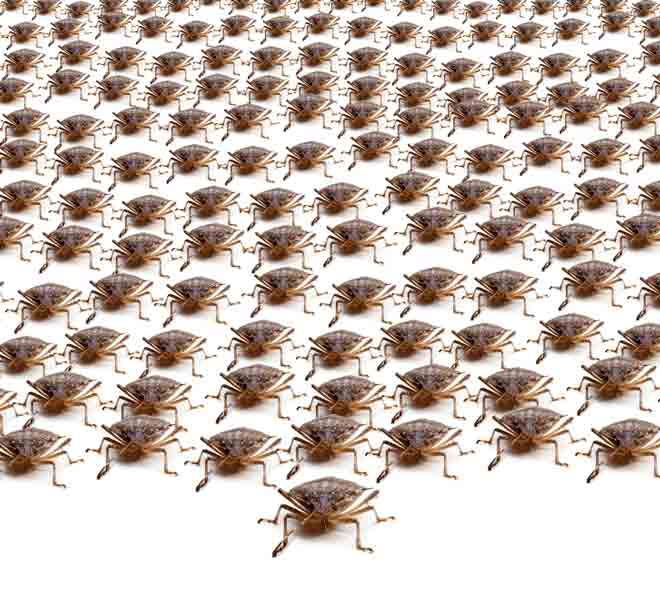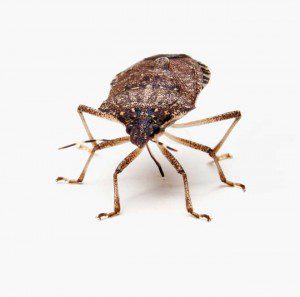Reports of gardeners struggling with deformed green beans and other crops this summer were a mystery that was assigned to everything from poor pollination to bad seeds.
The culprit has finally been identified as the Brown Marmorated Stink Bug, an exotic pest that is making its rounds to gardens and farms here in Pennsylvania as well as other states spread across the country.
 Here is an email about it that I received earlier this summer:
Here is an email about it that I received earlier this summer:
Brown Marmorated Stink Bugs Create Confusion in Backyard Gardens
Kenny, early in the growing season I frantically asked you why my pole beans were producing scruffy, flat and curly beans.
It took awhile longer to determine that the culprit was the brown marmorated stink-bug, a new and highly destructive garden pest. They attack the blossoms and the leaves of beans that are attractive to the bug, preventing pollination and damaging the vines.
Interestingly, there was a remarkable difference among bean varieties. Of the lovely 3-in-1 variety pack from Renee’s Garden Seed Co. which I was so enamored with last year, not one produced a single good bean.
The Hopes for an Organic Solution to Control this New Pest
In contrast, Renee’s “Spanish Musica” has been left completely untouched. Why the stink-bugs don’t care for it is a mystery. Also, Territorials’ “Painted Lady” Scarlet Runner Bean is doing well; the leaves are undamaged and it has begun setting out beans, it is also a late season producer here.
Government entomologists are promising a pheromone trap for next season, like the trap for the Japanese Beetle. I do hope they are able to keep their promise. In the meantime, it’s up to us gardeners to plant a wide variety of seeds to help determine which are susceptible and which are resistant to damage by the brown marmorated stink-bug.
Even the small space gardener can participate in this project. That information, shared on blogs like yours, will help us fight with the best of all tools… Natural Selection. Peace in the Garden, Barb K.
Penn State University Warns of the Coming Stink bug Invasion
Not long after Barb’s description of the damage that Brown Marmorated Stink Bugs were causing in her garden, I received an alert through an Ag Newswire from Penn State University regarding these pests and the havoc that they have been creating here within the state and beyond.
received an alert through an Ag Newswire from Penn State University regarding these pests and the havoc that they have been creating here within the state and beyond.
The newswire titled; “Researchers seek elusive answers to stink-bug infestations” was prefaced with the following introduction:
Many homes and orchards in the mid-Atlantic region have been overrun by the brown marmorated stink bug, the latest in what seems to be a steady stream of exotic, invasive insects that have found their way into the United States in recent years.
And as with many of its fellow interlopers — such as the Asian long horned beetle and the emerald ash borer — experts haven’t yet identified any good solutions for managing or eradicating the pest.
So it appears that the Brown Marmorated Stink Bug is a recent introduction and not a native species to the U.S. and as is often the case with foreign plant and insect invaders, it may turn into a huge challenge to control once it settles into a new territory. You can read the full Penn State University article at: http://live.psu.edu/story/48793#nw69
A Follow Up from Barb, the Small Space Gardener
And Barb wasn’t finished outlining her encounter with the Brown Marmorated Stink Bug in Virginia, here is a subsequent email that she shared regarding the destructive impact on her green beans:
It seems that the larval stage (of the stink bug) focuses on the blossoms, either eating the blossom entirely, or just the reproductive parts, so the beans that form are seedless and misshapen. I did not see any larvae, or blossoms for that matter, on some of the beans. I didn’t realize what was going on until late in the season when I was picking pears and noticed an unusual number of stink-bugs buzzing above the bean vines.
That was when I decided the affected beans had to go. I cut and unstrung the yellow, broad green and purple bean plants. I had not seen blossoms all season on the yellow or purple. The broad green beans were the curly, sterile ones of the original complaint. All those plants were tied up and sent to the county incinerator. No way are they going into the compost!
Seeking Answers to the Brown Marmorated Stinkbug Dilemma
The late season string beans (Spanish Music) seemed to be completely unaffected by the stinkbugs. I pickled 7 quarts of dilly beans and have had fresh beans every night. They are nearly done and are slowing production.
The scarlet runner beans were somewhat affected, most pods had only one or two beans, and in the clusters, more were spindly than fat. I did get a handful or two, but not what I should have gotten. It looks like they have given up for the season completely.
I have heard that around the region, the new stinkbug has begun to show its’ destructive capability and has impacted farmer’s fields. Let’s hope for a pheromone and trap solution soon! Peace in the Garden, Barb.
Thanks Barb, fortunately my garden was spared this summer! I noticed more stinkbugs getting inside the house than what I saw causing any trouble in the garden. That was also the biggest complaint I heard related to stink bugs in the general area… that they were finding their way into homes and buildings.
So I’m not even sure if they were the Brown Marmorated species or some other type that was being spotted nearby. If anyone has additional insight, experiences, or an effective organic control to share please leave your feedback in the comment section below. Thanks!



12 Responses
I, too, had these all over my squash and eggplants. I was able to keep them at bay with a sprinkling of fresh broken up serrano peppers that I placed on the ground around the stems. There were a few that did get on the low hanging leaves, but for the most part the peppers seemed to help. That and liguid Sevin when the plants were young.
We have some stink bugs here in Australia and they love to eat Avocados. These guys stick holes in the Avo and puncture the skin.
This can create woody hard bits inside the fruit and make it unpleasant to eat.
The Assasin Bug will eat the lava of the stink bugs though, and keep them slightly under control.
Its a good idea to invite predators into your garden that clean up pest.
They may not get all of them, but will kill off most.
Keep mono culture and mix up your plants. This puts the pests off scent and stops them from jumping onto the next available plant.
Don’t make it too easy fro them.
Happy Gardening
Marty,Karin and the Potted Vegetable Garden
I had problems with (Brown Marmorated Stink Bugs) only my yellow peppers. I also had green and red peppers from the same store, purchased at the same time, and they grew unscathed. The yellow peppers had small blackish holes in the bottom of the pepper; only one grew to usable size but still needed the hole removed before use.
I had an episode with either the same bug or similar (not sure what one is going around here in Arizona) with my pumpkins this summer. The plant started growing just fine and I had plenty of blossoms. However, I could never find any growing pumpkins. I thought I had a pollination problem. It wasn’t until I pulled the plants out months later that I found the stink bugs in droves.
Then a week ago I found another one hanging out on my Basil plant. Thanks for keeping up on this, I know now what to keep my eye out for.
I have seen these really come in strong in Southwest Louisiana over the past 2 years. I noticed that when I planted sunflowers outside my garden, the stink bugs went to the sunflowers first and actualy stayed on them for about 2 weeks before they moved to my garden. As soon as I started seeing them on my vegies and i tried ivory soap mixed with water and peppers but that did not phase them, so i hit them with some 7 dust to finish them off. You can check out the pics on my blog:
http://themtrahans.com/wordpress/?p=221
These guys totally destroyed my pumpkin plants this year… I was trying to go organic and couldn’t find a way to slow them down. Might have to try pepper like someone mentioned above if they are back this year.
I like them, I think they are cute, and if you watch them, they have personality 🙂
These bugs have over run western PA. For a time, people thought they didn’t do anything harmful. I did not have troubles in my garden with them last year, but they seemed to go crazy in the fall. I hope they find a pheremone trap soon.
I was really disappointed with all the reporting last year that these were just a an annoyance. That was until the fruit and vegetable growers started alerting us to the losses they were seeing. I don’t know if it was the extreme heat or the unusual snow pack we experienced in Maryland last year but I’ve never seen them quite that bad. Most of my garden was a bust due to the heat but my tomatoes thrived. Only problem was each ripe fruit picked had a Stink bug feeding on the bottom of it. So I guess it’s time to experiment to see the best approach. The parasitic wasp release is 2 years away providing it is a safe solution to the environment.
My mother in law said the sparrows around her house have started eating these pesky bugs. Here’s hoping that other sparrows across the state begin doing the same.
They are a Japanese beetle that has no natural predators in the US. Until, the sparrows at my mother in law’s house.